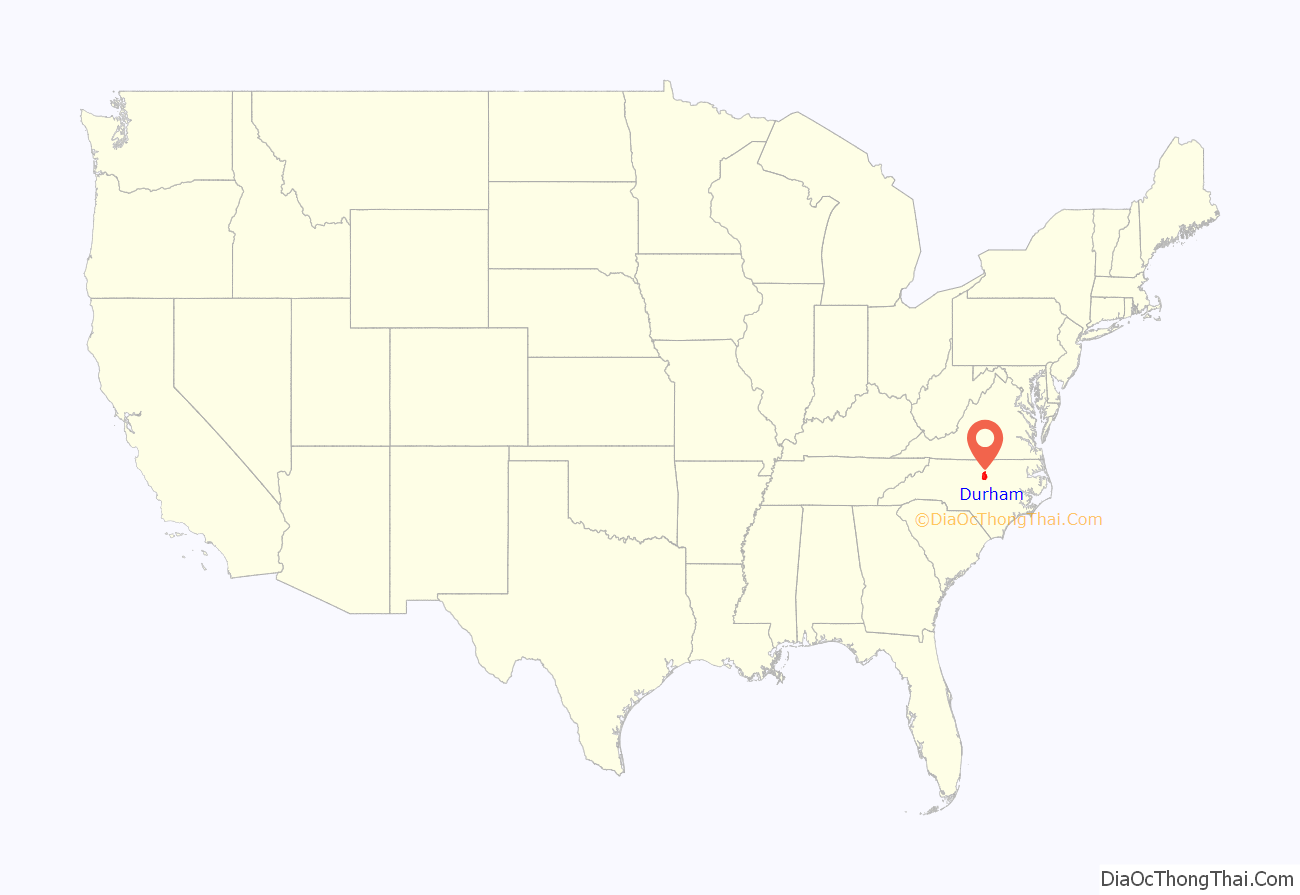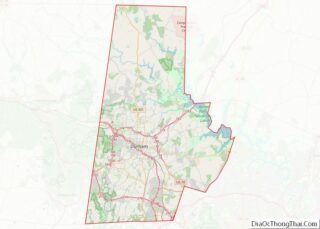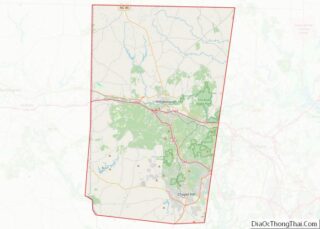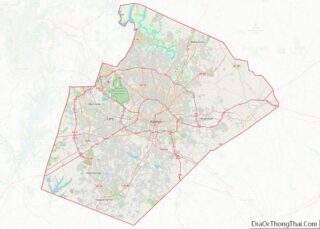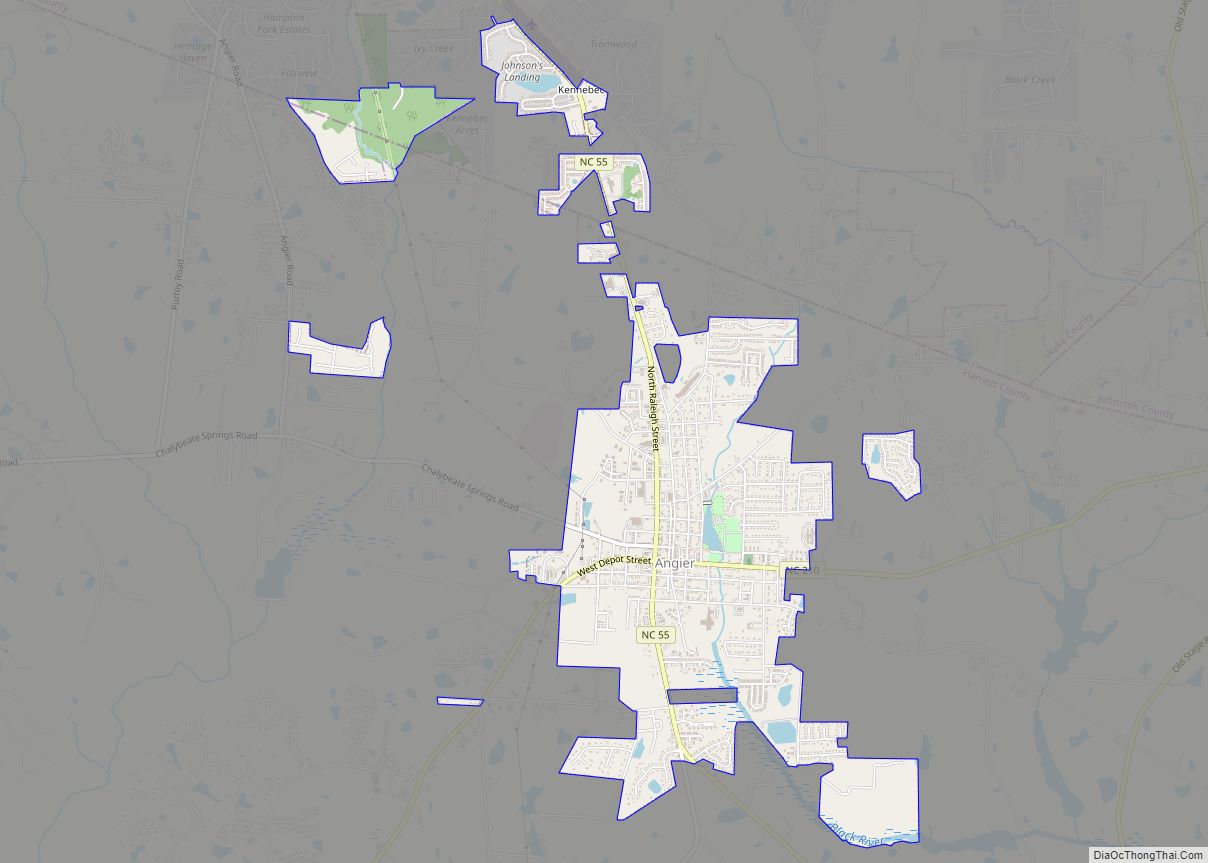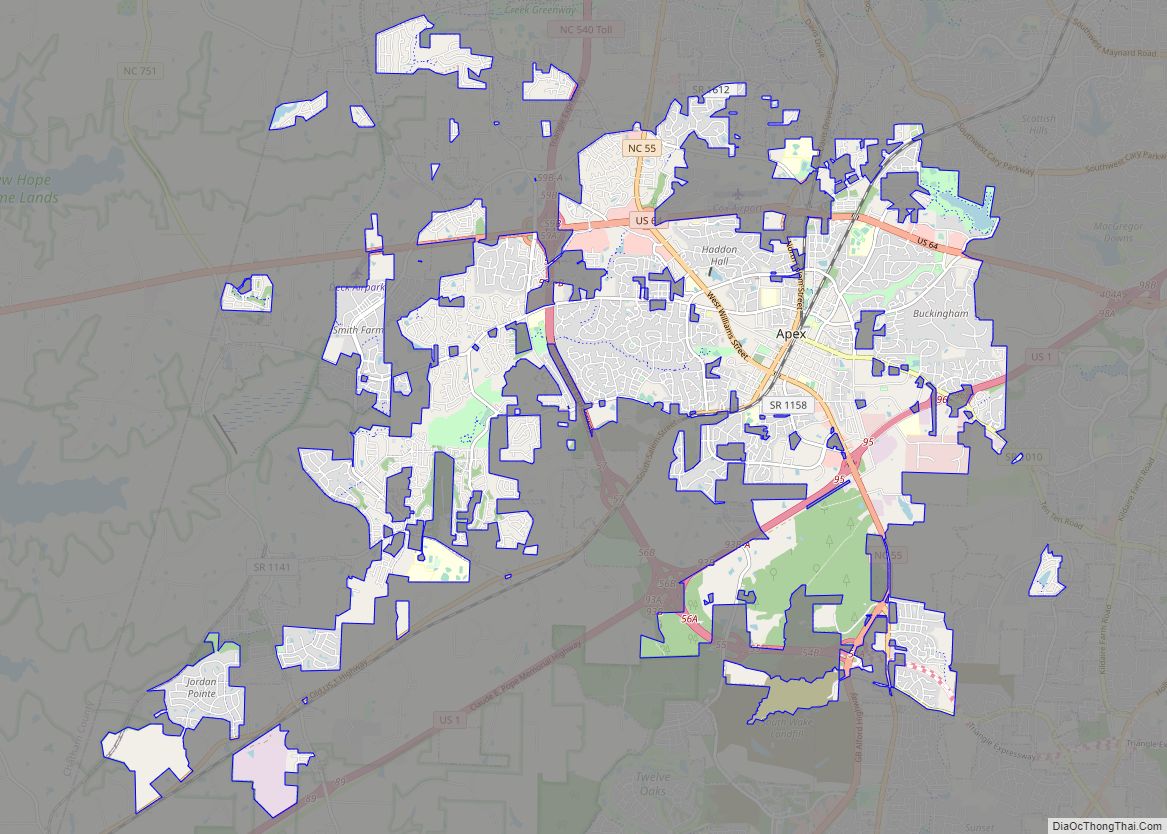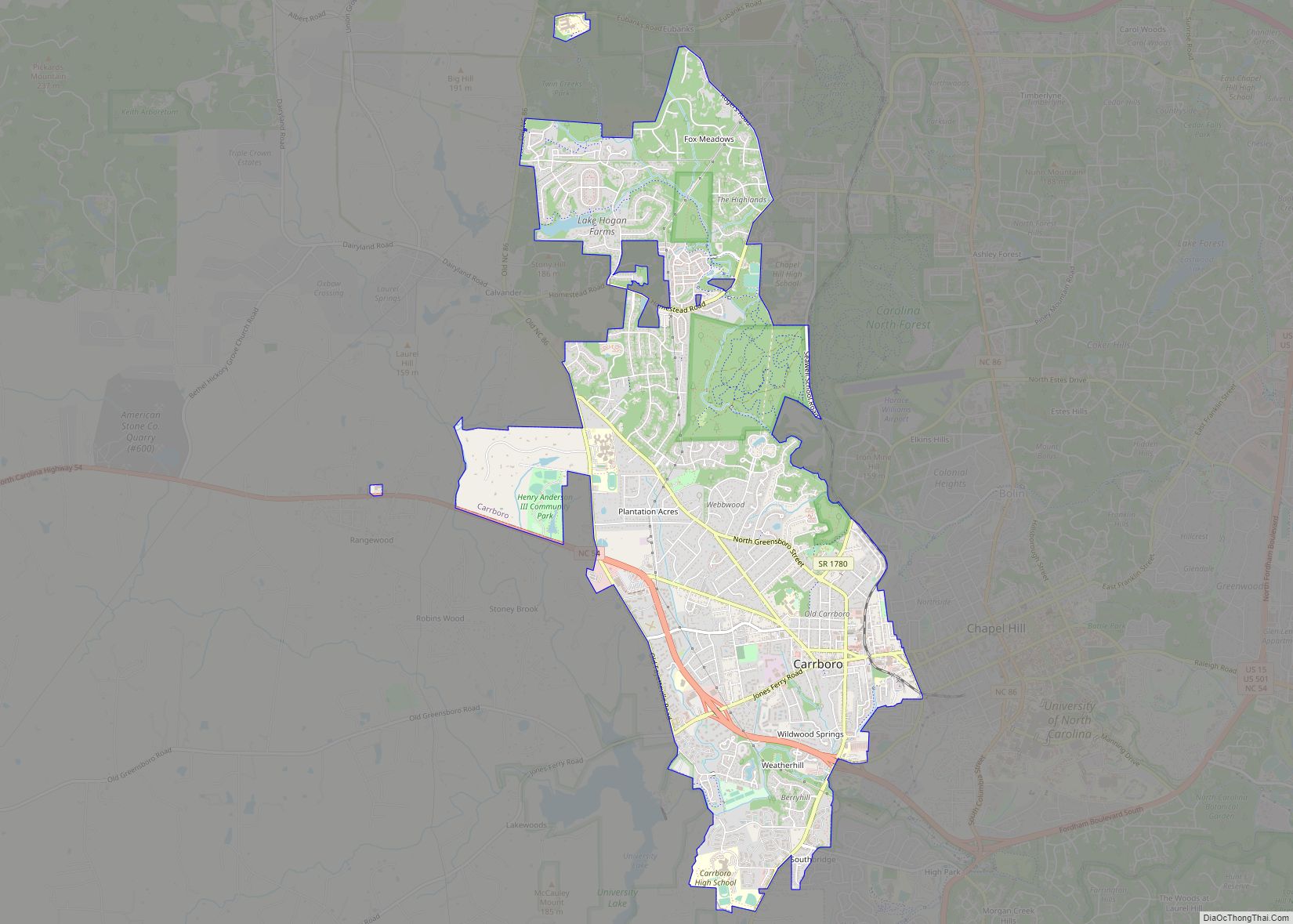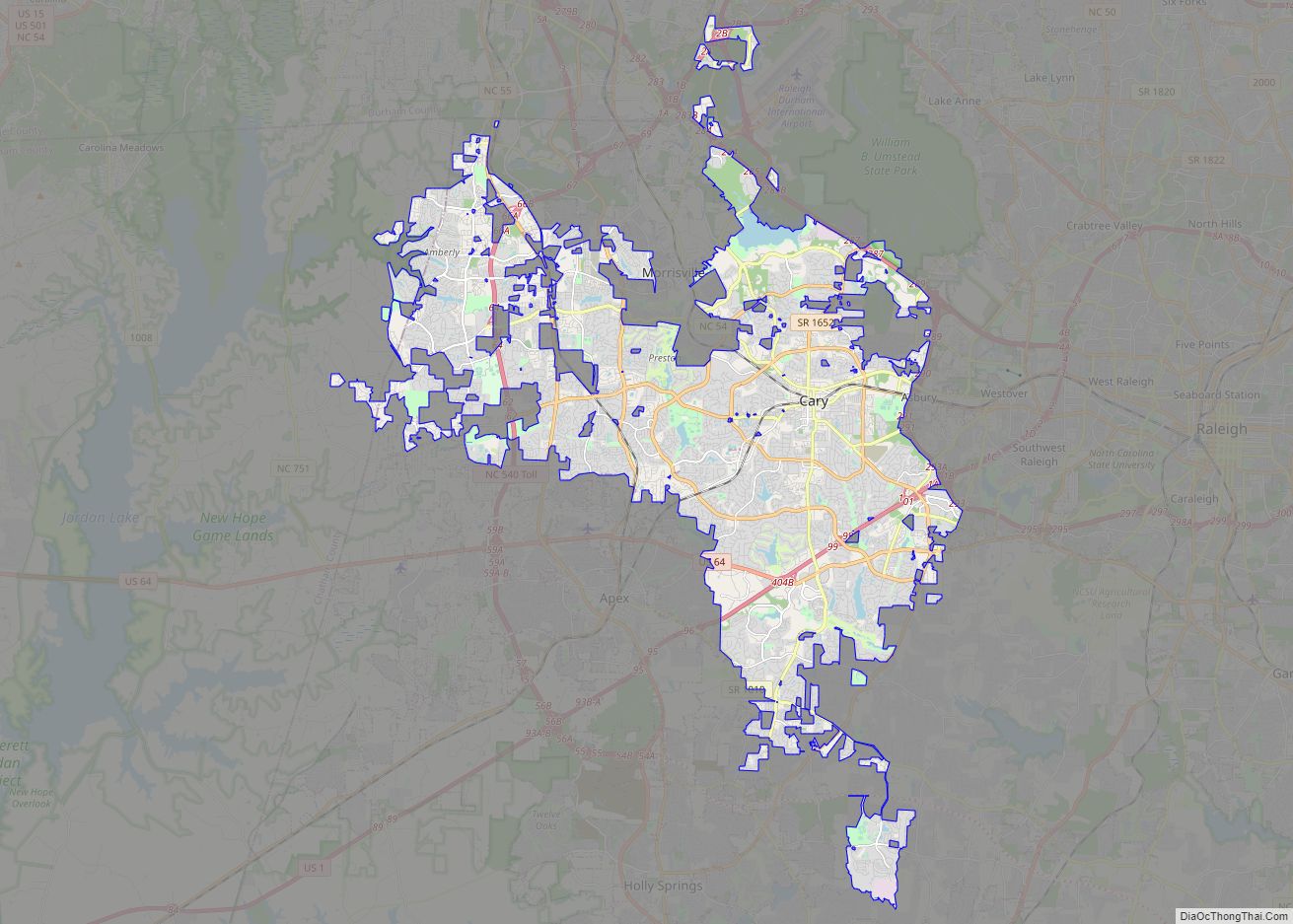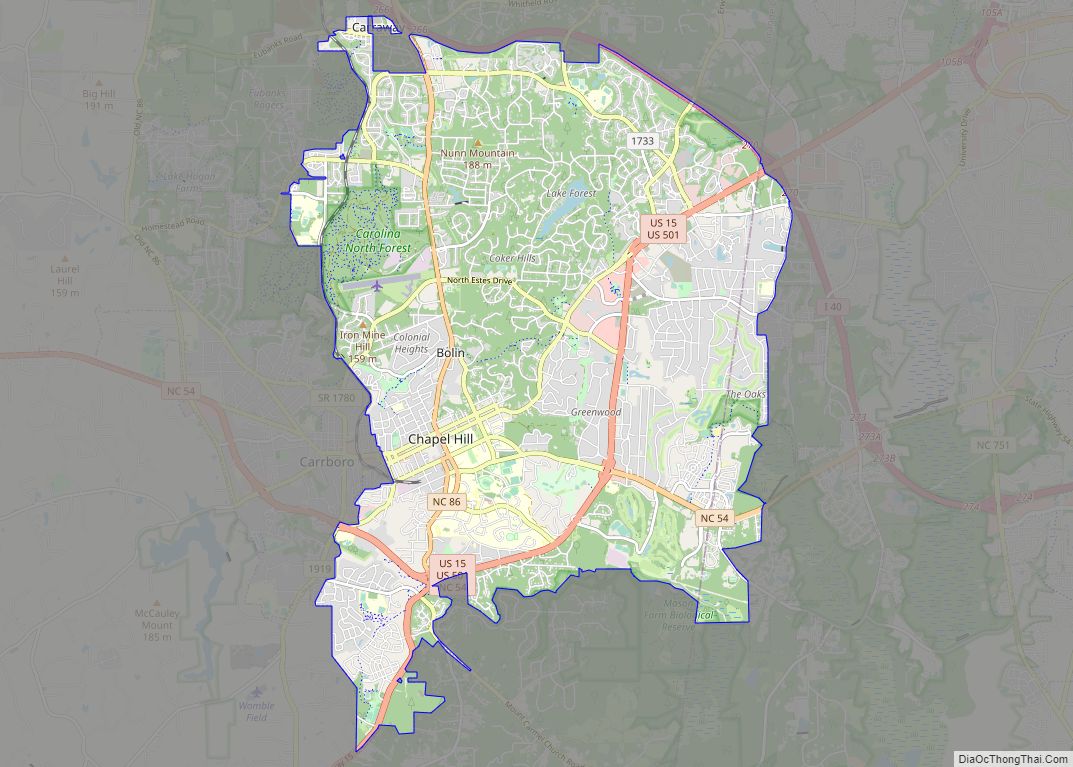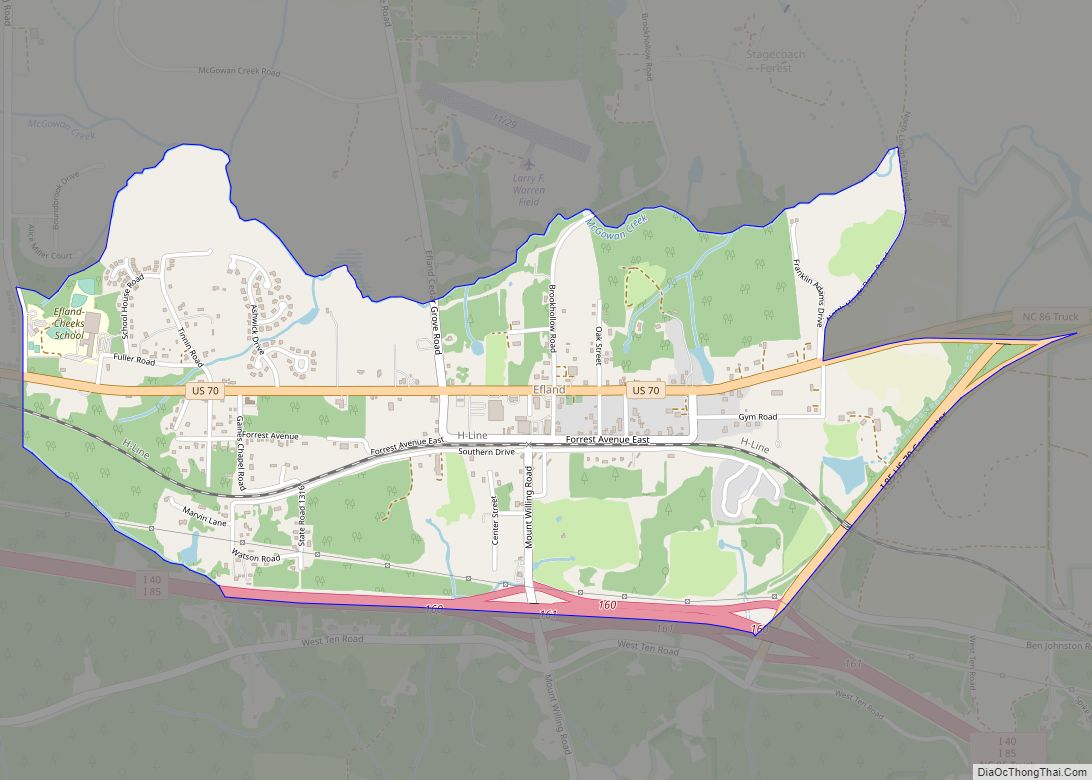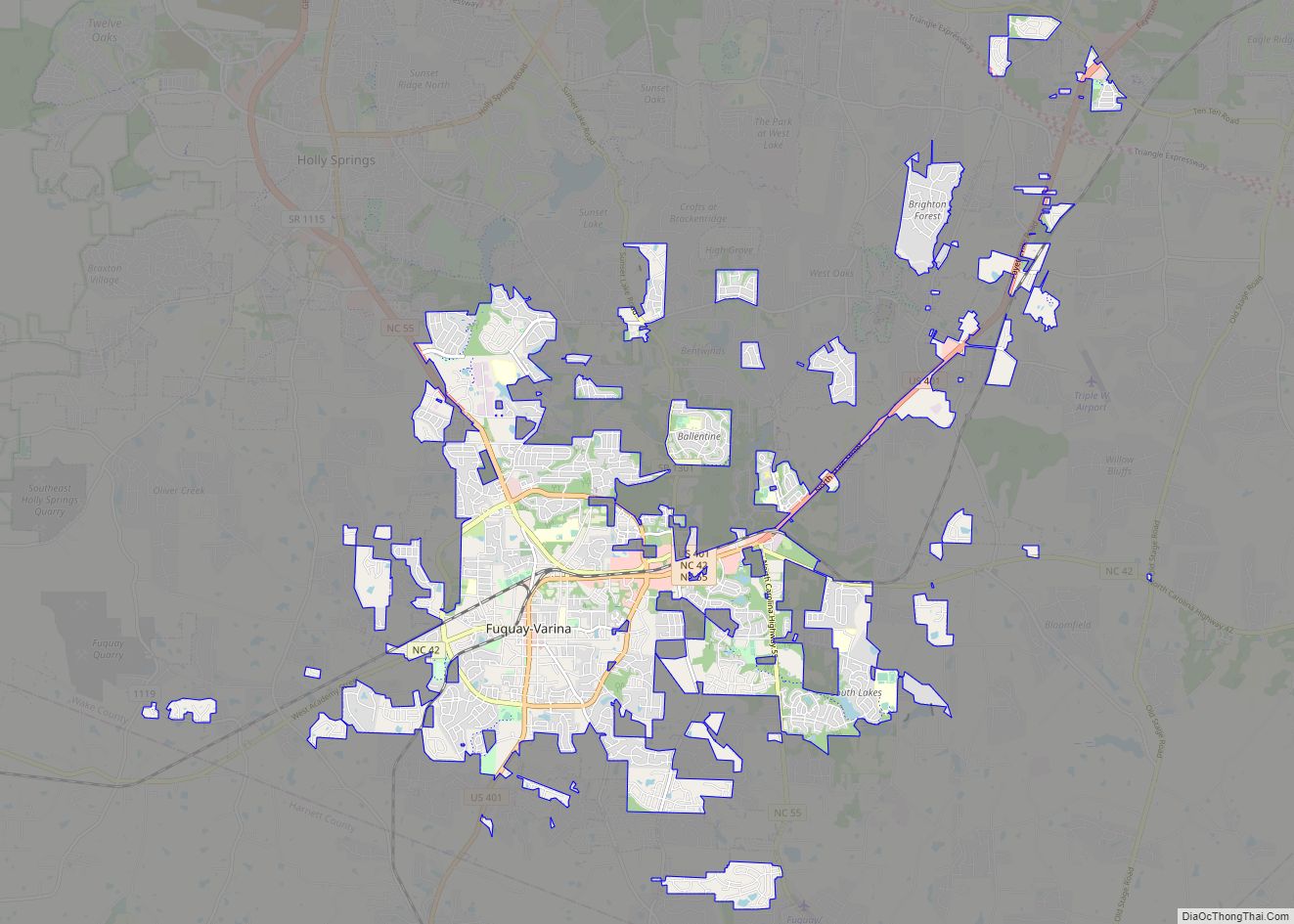Durham (/ˈdʌrəm/ DURR-əm) is a city in the U.S. state of North Carolina and the county seat of Durham County. Small portions of the city limits extend into Orange County and Wake County. With a population of 283,506 in the 2020 census, Durham is the 4th-most populous city in North Carolina, and the 74th-most populous city in the United States. The city is located in the east-central part of the Piedmont region along the Eno River. Durham is the core of the four-county Durham-Chapel Hill Metropolitan Area, which had a population of 649,903 at the 2020 census. The Office of Management and Budget also includes Durham as a part of the Raleigh-Durham-Cary Combined Statistical Area, commonly known as the Research Triangle, which had a population of 2,043,867 at the 2020 census.
A railway depot was established in 1849 on land donated by Bartlett S. Durham, the namesake of the city. Following the American Civil War, the community of Durham Station expanded rapidly, in part due to the tobacco industry. The town was incorporated by act of the North Carolina General Assembly, in April 1869. The establishment of Durham County was ratified by the General Assembly 12 years later, in 1881. It became known as the founding place and headquarters of the American Tobacco Company. Textile and electric power industries also played an important role. While these industries have declined, Durham underwent revitalization and population growth to become an educational, medical, and research center.
Durham is home to several recognized institutions of higher education, most notably Duke University and North Carolina Central University. Durham is also a national leader in health-related activities, which are focused on the Duke University Hospital and many private companies. Duke and its Duke University Health System are the largest employers in the city. North Carolina Central University is a historically black university that is part of the University of North Carolina system. Together, the two universities make Durham one of the vertices of the Research Triangle area; central to this is the Research Triangle Park south of Durham, which encompasses an area of 11 square miles and is devoted to research facilities.
On the Duke University campus are the neo-Gothic Duke Chapel and the Nasher Museum of Art. Other notable sites in the city include the Museum of Life and Science, Durham Performing Arts Center, Carolina Theatre, and Duke Homestead and Tobacco Factory. Bennett Place commemorates the location where Joseph E. Johnston surrendered to William T. Sherman in the American Civil War. The city is served, along with Raleigh, by Raleigh–Durham International Airport.
| Name: | Durham city |
|---|---|
| LSAD Code: | 25 |
| LSAD Description: | city (suffix) |
| State: | North Carolina |
| County: | Durham County, Orange County, Wake County |
| Incorporated: | April 10, 1869 |
| Elevation: | 404 ft (123 m) |
| Land Area: | 115.36 sq mi (298.79 km²) |
| Water Area: | 0.82 sq mi (2.13 km²) |
| Population Density: | 2,457.51/sq mi (948.85/km²) |
| ZIP code: | 27701, 27702, 27703, 27704, 27705, 27706, 27707, 27708, 27709, 27710, 27711, 27712, 27713, 27715, 27717, 27722 |
| Area code: | 919, 984 |
| FIPS code: | 3719000 |
| GNISfeature ID: | 1020059 |
| Website: | durhamnc.gov |
Online Interactive Map
Click on ![]() to view map in "full screen" mode.
to view map in "full screen" mode.
Durham location map. Where is Durham city?
History
Pre-establishment
The Eno and the Occoneechi, related to the Sioux and the Shakori, lived and farmed in the area which became Durham. They may have established a village named Adshusheer on the site. The Great Indian Trading Path has been traced through Durham, and Native Americans helped to mold the area by establishing settlements and commercial transportation routes.
In 1701, Durham’s beauty was chronicled by the English explorer John Lawson, who called the area “the flower of the Carolinas.” During the mid-1700s, Scots, Irish, and English colonists settled on land granted to George Carteret by King Charles I (for whom the Carolinas are named). Early settlers built gristmills, such as West Point, and worked the land.
Prior to the American Revolution, frontiersmen in what is now Durham were involved in the Regulator movement. According to legend, Loyalist militia cut Cornwallis Road through this area in 1771 to quell the rebellion. Later, William Johnston, a local shopkeeper and farmer, made Revolutionaries’ munitions, served in the Provincial Capital Congress in 1775, and helped underwrite Daniel Boone’s westward explorations.
Antebellum and Civil War
Prior to the arrival of the railroad, the area now known as Durham was the eastern part of present-day Orange County and was almost entirely agricultural, with a few businesses catering to travelers (particularly livestock drivers) along the Hillsborough Road. This road, eventually followed by US Route 70, was the major east–west route in North Carolina from colonial times until the construction of interstate highways. Steady population growth and an intersection with the road connecting Roxboro and Fayetteville made the area near this site suitable for a US Post Office. Roxboro, Fayetteville and Hillsborough Roads remain major thoroughfares in Durham, although they no longer exactly follow their early 19th century rights-of-way.
Large plantations, Hardscrabble, Fairntosh, Lipscomb, Walnut Hall, Patterson, and Leigh among them, were established in the antebellum period. By 1860, Stagville Plantation lay at the center of one of the largest plantation holdings in the South. African slaves were brought to labor on these farms and plantations, and slave quarters became the hearth of distinctively Southern cultural traditions involving crafts, social relations, life rituals, music, and dance. There were free African-Americans in the area as well, including several who fought in the Revolutionary War.
Durham’s location is a result of the needs of the 19th century railroad industry. The wood-burning steam locomotives of the time had to stop frequently for wood and water and the new North Carolina Railroad needed a depot between the settled towns of Raleigh and Hillsborough. The residents of what is now downtown Durham thought their businesses catering to livestock drivers had a better future than “a new-fangled nonsense like a railroad” and refused to sell or lease land for a depot. In 1849, a North Carolina Railroad depot was established on a four-acre tract of land donated by Dr. Bartlett S. Durham; the station was named after him in recognition of his gift. A U.S. post office was established there on April 26, 1853, now recognized as the city’s official birthday.
Durham Station, as it was known for its first 20 years, was a depot for the occasional passenger or express package until early April 1865, when the Federal Army commanded by Major General William T. Sherman occupied the nearby state capital of Raleigh during the American Civil War. The last formidable Confederate Army in the South, commanded by General Joseph E. Johnston, was headquartered in Greensboro 50 miles (80 km) to the west. After the surrender of the Army of Northern Virginia by Gen. Robert E. Lee at Appomattox, Virginia on April 9, 1865, Gen. Johnston sought surrender terms, which were negotiated on April 17, 18 and 26 at Bennett Place, the small farm of James and Nancy Bennett, located halfway between the army’s lines about 3 miles (4.8 km) west of Durham Station.
As both armies passed through Durham, Hillsborough, and surrounding Piedmont communities, they enjoyed the mild flavor of the area’s Brightleaf tobacco, which was considered more pleasant to smoke or chew than was available back home after the war. Some began sending letters to Durham to get more.
Reconstruction and the rise of Durham tobacco
The community of Durham Station grew slowly before the Civil War, but expanded rapidly following the war. Much of this growth attributed to the establishment of a thriving tobacco industry. Veterans returned home after the war with an interest in acquiring more of the tobacco they had sampled in North Carolina. Numerous orders were mailed to John Ruffin Green’s tobacco company requesting more of the Durham tobacco. W.T. Blackwell partnered with Green and renamed the company as the “Bull Durham Tobacco Factory”. The name “Bull Durham” is said to have been taken from the bull on the British Colman’s Mustard, which Mr. Blackwell mistakenly believed was manufactured in Durham, England. Mustard known as Durham Mustard was originally produced in Durham, England, by Mrs Clements and later by Ainsley during the eighteenth century. However, production of the original Durham Mustard has now been passed into the hands of Colman’s of Norwich, England.
Incorporation
As Durham Station’s population rapidly increased, the station became a town and was incorporated by act of the North Carolina General Assembly, on April 10, 1869. It was named for the man who provided the land on which the station was built, Dr. Bartlett Durham. At the time of its incorporation by the General Assembly, Durham was located in Orange County. The increase in business activity, land transfers etc., made the day long trip back and forth to the county seat in Hillsborough untenable, so twelve years later, on April 17, 1881, a bill for the establishment of Durham County was ratified by the General Assembly, having been introduced by Caleb B.Green, creating Durham County from the eastern portion of Orange County and the western portion of Wake County. In 1911, parts of Cedar Fork Township of Wake County was transferred to Durham County and became Carr Township.
Early growth (1900–1970)
The rapid growth and prosperity of the Bull Durham Tobacco Company, and Washington Duke’s W. Duke & Sons Tobacco Company, resulted in the rapid growth of the city of Durham. Washington Duke was a good businessman, but his sons were brilliant and established what amounted to a monopoly of the smoking and chewing tobacco business in the United States by 1900. In the early 1910s, the Federal Government forced a breakup of the Duke’s business under the antitrust laws. The Dukes retained what became known as American Tobacco, a major corporation in its own right, with manufacturing based in Durham. American Tobacco’s ubiquitous advertisements on radio shows beginning in the 1930s and television shows up to 1970 was the nation’s image of Durham until Duke University supplanted it in the late 20th century.
Prevented from further investment in the tobacco industry, the Dukes turned to the then new industry of electric power generation, which they had been investing in since the early 1890s. Duke Power (now Duke Energy) brought in electricity from hydroelectric dams in the western mountains of North Carolina through the newly invented technology of high voltage power lines. At this time (1910–1920), the few towns and cities in North Carolina that had electricity depended on local “powerhouses”. These were large, noisy, and smoky coal-fired plants located next to the railroad tracks. Duke Power quickly took over the electricity franchises in these towns and then electrified all the other towns of central and western North Carolina, making even more money than they ever made from tobacco. Duke Power also had a significant business in local franchises for public transit (buses and trolleys) before local government took over this responsibility in the mid- to late 20th century. Duke Power ran Durham’s public bus system (now the Durham Area Transit Authority) until 1991.
The success of the tobacco industry in the late 19th and early 20th century encouraged the then-growing textile industry to locate just outside Durham. The early electrification of Durham was also a large incentive. Drawing a labor force from the economic demise of single family farms in the region at the time, these textile mills doubled the population of Durham. These areas were known as East Durham and West Durham until they were eventually annexed by the City of Durham.
Much of the early city architecture, both commercial and residential, dates from the period of 1890–1930. Durham recorded its worst fire in history on March 23, 1914. The multimillion-dollar blaze destroyed a large portion of the downtown business district. The fire department’s water source failed during the blaze, prompting voters to establish a city-owned water system in place of the private systems that had served the city since 1887.
Durham quickly developed a black community, the center of which was an area known as Hayti, (pronounced HAY-tie), just south of the center of town, where some of the most prominent and successful black-owned businesses in the country during the early 20th century were established. These businesses — the best known of which are North Carolina Mutual Life Insurance Company and Mechanics & Farmers Bank — were centered on Parrish St., which would come to be known as “Black Wall Street.” In 1910, Dr. James E. Shepard founded North Carolina Central University, the nation’s first publicly supported liberal arts college for African-Americans.
In 1924, James Buchanan Duke established a philanthropic foundation in honor of his father Washington Duke to support Trinity College in Durham. The college changed its name to Duke University and built a large campus and hospital a mile west of Trinity College (the original site of Trinity College is now known as the Duke East Campus).
Durham’s manufacturing fortunes declined during the mid-20th century. Textile mills began to close during the 1930s. Competition from other tobacco companies (as well as a decrease in smoking after the 1960s) reduced revenues from Durham’s tobacco industry.
In a far-sighted move in the late 1950s, Duke University, along with the University of North Carolina in Chapel Hill and North Carolina State University in Raleigh, persuaded the North Carolina Legislature to purchase a large tract of sparsely settled land in southern Durham County and create the nation’s first “science park” for industry. Cheap land and a steady supply of trained workers from the local universities made the Research Triangle Park an enormous success which, along with the expansion resulting from the clinical and scientific advances of Duke Medical Center and Duke University, more than made up for the decline of Durham’s tobacco and textile industries.
Civil rights movement
As a result of its substantial African-American community, including many activists, a prominent civil rights movement developed in Durham. Multiple sit-ins were held, and Martin Luther King Jr., visited the city during the struggle for equal rights. The Durham Committee on Negro Affairs, organized in 1935 by C.C. Spaulding, Louis Austin, Conrad Pearson, and James E. Shepard, has been cited nationally for its role in fighting for black voting rights. The committee also has used its voting strength to pursue social and economic rights for African-Americans and other ethnic groups. In 1957, Douglas E. Moore, minister of Durham’s Asbury Temple Methodist Church, along with other religious and community leaders, pioneered sit-ins throughout North Carolina to protest discrimination at lunch counters that served only whites.
Widely credited as the first sit-in of the civil rights movement in North Carolina, on June 23, 1957, Moore and six others assembled at the church to plan the protest. The young African Americans moved over to the segregated Royal Ice Cream Parlor and took up whites-only booths. When they refused to budge, the manager called the police who charged them with trespassing. Unlike the Greensboro Four, three years later, the Royal Seven were arrested and ultimately found guilty of trespassing.
The six-month-long sit-in at a Woolworth’s counter in Greensboro, NC, captured the nation’s attention. Within a week, students from North Carolina College at Durham and Duke University staged a sit-in in Durham. About a week later, Martin Luther King Jr. met Moore in Durham, where King coined his famous rallying cry “Fill up the jails,” during a speech at White Rock Baptist Church. Advocating non-violent confrontation with segregation laws for the first time, King said, “Let us not fear going to jail. If the officials threaten to arrest us for standing up for our rights, we must answer by saying that we are willing and prepared to fill up the jails of the South.”
This community was not enough to prevent the demolition of portions of the Hayti district for the construction of the Durham Freeway during the late 1960s. The freeway construction resulted in losses to other historic neighborhoods, including Morehead Hill, West End, and West Durham. Combined with large-scale demolition using Urban Renewal funds, Durham suffered significant losses to its historic architectural base.
1970s – present
In 1970, the Census Bureau reported city’s population as 38.8% black and 60.8% white. Durham’s growth began to rekindle during the 1970s and 1980s, with the construction of multiple housing developments in the southern part of the city, nearest Research Triangle Park, and the beginnings of downtown revitalization. In 1975, the St. Joseph’s Historical Foundation at the Hayti Heritage Center was incorporated to “preserve the heritage of the old Hayti community, and to promote the understanding of and appreciation for the African American experience and African Americans’ contributions to world culture.” A new downtown baseball stadium was constructed for the Durham Bulls in 1994. The Durham Performing Arts Center now ranks in the top ten in theater ticket sales in the US according to Pollstar magazine. Many famous people have performed there including B.B. King and Willie Nelson. After the departure of the tobacco industry, large-scale renovations of the historic factories into offices, condominiums, and restaurants began to reshape downtown. While these efforts continue, the large majority of Durham’s residential and retail growth since 1990 has been along the I-40 corridor in southern Durham County.
Major employers in Durham are Duke University and Duke Medical Center (39,000 employees, 14,000 students), about 2 miles (3.2 km) west of the original downtown area, and companies in the Research Triangle Park (49,000 employees), about 10 miles (16 km) southeast. These centers are connected by the Durham Freeway (NC 147).
Downtown revitalization
In recent years the city of Durham has stepped up revitalization of its downtown and undergone an economic and cultural renaissance of sorts. Partnering with developers from around the world, the city continues to promote the redevelopment of many of its former tobacco districts, projects supplemented by the earlier construction of the Durham Performing Arts Center and new Durham Bulls Athletic Park. The American Tobacco Historic District, adjacent to both the athletic park and performing arts center, is one such project, having successfully lured a number of restaurants, entertainment venues, and office space geared toward hi-tech entrepreneurs, investors, and startups. Many other companies have purchased and renovated historic buildings, such as Measurement Incorporated and Capitol Broadcasting Company. The American Underground section of the American Tobacco Campus, home to successful small software firms including Red Hat, was selected by Google to host its launch of the Google Glass Road show in October 2013. The district is also slated for expansion featuring 158,000 square feet of offices, retail, residential or hotel space The Durham County Justice Center, a major addition to downtown Durham, was completed in early 2013.
Many of the historic tobacco buildings elsewhere in the city have been converted into loft-style apartment complexes. The downtown corridor along West Main St. has seen significant redevelopment including bars, entertainment venues, art studios, and co-working spaces, in addition to shopping and dining in nearby Brightleaf Square, another former tobacco warehouse in the Bright Leaf Historic District. Other current and future projects include expansion of the open-space surrounding the American Tobacco Trail, new hotels and apartment complexes, a $6.35-million facelift of Durham City Hall, and ongoing redevelopment of the Duke University Central Campus.
In 2013, 21c Museum Hotels announced plans to fully renovate the Hill Building. The renovations added a contemporary art museum and upscale restaurant to the historic building. Additionally, a boutique hotel was built in this major renovation effort in downtown Durham. Skanska is responsible for managing this project.
In 2014, it was announced that downtown Durham would be the site of a brand new 27 story high building, tentatively named “City Center Tower”, titled “One City Center” as of 2018. Along with other new buildings in downtown Durham, it was under construction in 2018. Construction has already started, and the building will be at the corner of Main St. and Corcoran St. It will be directly across from Durham’s current tallest building, but once completed, will be the new tallest building in downtown Durham and the 4th largest building in the Triangle. Originally scheduled for a 2016 opening, the building was then expected to open in May 2018. This is an ambitious, $80 million project.
In October 2014, a major new development, the Durham Innovation District, was announced. The development will span 15 acres and comprise over 1.7 million square feet of office, residential, and retail space.
On April 10, 2019, a gas explosion rocked Kaffeinate, a coffee shop in Bright Leaf Historic District. The blast destroyed a city block and killed Kong Lee, the owner, as well as injuring 25 others.
Durham Road Map
Durham city Satellite Map
Geography
Durham is located in the east-central part of the Piedmont region at 35°59′19″N 78°54′26″W / 35.98861°N 78.90722°W / 35.98861; -78.90722 (35.988644, −78.907167). Like much of the region, its topography is generally flat with some rolling hills.
The city has a total area of 108.3 square miles (280.4 km), of which 107.4 square miles (278.1 km) is land and 0.93 square miles (2.4 km), or 0.84%, is water.
The soil is predominantly clay, making it poor for agriculture. The Eno River, a tributary of the Neuse River, passes through the northern part of Durham, along with several other small creeks. The center of Durham is on a ridge that forms the divide between the Neuse River watershed, flowing east to Pamlico Sound, and the Cape Fear River watershed, flowing south to the Atlantic near Wilmington. A small portion of the city is in Wake County.
Durham is located 10.41 miles northeast of Chapel Hill, 20.78 miles northwest of Raleigh, 50.21 miles east of Greensboro, 121.40 miles northeast of Charlotte and 134.06 miles southwest of Richmond, Virginia.
Cityscape
Climate
Durham is classified as a humid subtropical climate (Cfa) according to the Köppen classification, with hot and humid summers, cool winters, and warm to mild spring and autumn. Durham receives abundant precipitation, with thunderstorms common in the summer and temperatures from 80 to 100 degrees F. The region sees an average of 6.8 inches (170 mm) of snow per year, which usually melts within a few days.
Durham consistently ranks in the top 10 least challenging places to live with seasonal allergies.
Climate change is expected to increase the number of days of extreme precipitation in Durham as well as moderately increase temperature within the region. The number of days of inland flooding within the Piedmont is also expected to increase, which puts Durham at higher risk of future flooding. High intensity short duration storms are predicted to grow in frequency to upwards of 9 days a year by 2100. Inland flooding is anticipated to have a greater impact on the elderly and other at-risk groups in Durham.
See also
Map of North Carolina State and its subdivision:- Alamance
- Alexander
- Alleghany
- Anson
- Ashe
- Avery
- Beaufort
- Bertie
- Bladen
- Brunswick
- Buncombe
- Burke
- Cabarrus
- Caldwell
- Camden
- Carteret
- Caswell
- Catawba
- Chatham
- Cherokee
- Chowan
- Clay
- Cleveland
- Columbus
- Craven
- Cumberland
- Currituck
- Dare
- Davidson
- Davie
- Duplin
- Durham
- Edgecombe
- Forsyth
- Franklin
- Gaston
- Gates
- Graham
- Granville
- Greene
- Guilford
- Halifax
- Harnett
- Haywood
- Henderson
- Hertford
- Hoke
- Hyde
- Iredell
- Jackson
- Johnston
- Jones
- Lee
- Lenoir
- Lincoln
- Macon
- Madison
- Martin
- McDowell
- Mecklenburg
- Mitchell
- Montgomery
- Moore
- Nash
- New Hanover
- Northampton
- Onslow
- Orange
- Pamlico
- Pasquotank
- Pender
- Perquimans
- Person
- Pitt
- Polk
- Randolph
- Richmond
- Robeson
- Rockingham
- Rowan
- Rutherford
- Sampson
- Scotland
- Stanly
- Stokes
- Surry
- Swain
- Transylvania
- Tyrrell
- Union
- Vance
- Wake
- Warren
- Washington
- Watauga
- Wayne
- Wilkes
- Wilson
- Yadkin
- Yancey
- Alabama
- Alaska
- Arizona
- Arkansas
- California
- Colorado
- Connecticut
- Delaware
- District of Columbia
- Florida
- Georgia
- Hawaii
- Idaho
- Illinois
- Indiana
- Iowa
- Kansas
- Kentucky
- Louisiana
- Maine
- Maryland
- Massachusetts
- Michigan
- Minnesota
- Mississippi
- Missouri
- Montana
- Nebraska
- Nevada
- New Hampshire
- New Jersey
- New Mexico
- New York
- North Carolina
- North Dakota
- Ohio
- Oklahoma
- Oregon
- Pennsylvania
- Rhode Island
- South Carolina
- South Dakota
- Tennessee
- Texas
- Utah
- Vermont
- Virginia
- Washington
- West Virginia
- Wisconsin
- Wyoming
